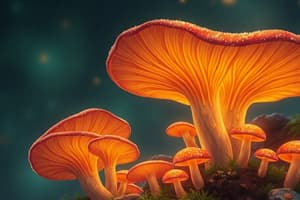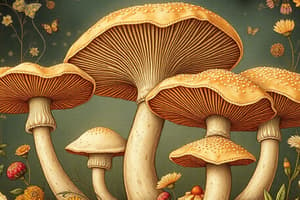Podcast
Questions and Answers
What is the primary field of study related to fungi?
What is the primary field of study related to fungi?
- Parasitology
- Virology
- Bacteriology
- Mycology (correct)
Which characteristic distinguishes fungi as a group of organisms?
Which characteristic distinguishes fungi as a group of organisms?
- Photosynthetic abilities
- Prokaryotic cells
- Eukaryotic cells (correct)
- Single-celled organisms
How do fungi typically interact with humans?
How do fungi typically interact with humans?
- They are usually harmful
- They are always beneficial
- They are normally harmless (correct)
- They require a host for survival
What type of membrane do fungi possess, distinguishing them from other organisms?
What type of membrane do fungi possess, distinguishing them from other organisms?
Which of the following statements about fungi is true?
Which of the following statements about fungi is true?
What condition may cause fungi to become pathogenic in a patient?
What condition may cause fungi to become pathogenic in a patient?
Which statement accurately describes fungi compared to bacteria?
Which statement accurately describes fungi compared to bacteria?
How do fungi contribute to cell structure?
How do fungi contribute to cell structure?
What is the most well-known toxin produced by fungi that is harmful to liver cells?
What is the most well-known toxin produced by fungi that is harmful to liver cells?
Which of the following is a key characteristic of acute suppuration?
Which of the following is a key characteristic of acute suppuration?
Which of the following individuals is at risk of pathogenic fungi due to immunosuppression?
Which of the following individuals is at risk of pathogenic fungi due to immunosuppression?
What type of immune response is primarily involved in fighting against fungal infections?
What type of immune response is primarily involved in fighting against fungal infections?
What distinguishes fungi from most bacteria?
What distinguishes fungi from most bacteria?
Which of the following statements about aflatoxin is correct?
Which of the following statements about aflatoxin is correct?
In the context of immune mechanisms against fungi, which immune cell type is the most significant in acute responses?
In the context of immune mechanisms against fungi, which immune cell type is the most significant in acute responses?
Which type of immunity primarily involves neutrophils in response to fungal infections?
Which type of immunity primarily involves neutrophils in response to fungal infections?
What is the primary laboratory method used for the culture of fungal organisms?
What is the primary laboratory method used for the culture of fungal organisms?
Which immune response is considered the most significant for acquired immunity against fungal infections?
Which immune response is considered the most significant for acquired immunity against fungal infections?
Which of the following is NOT a method used for the laboratory diagnosis of fungal infections?
Which of the following is NOT a method used for the laboratory diagnosis of fungal infections?
Which laboratory diagnosis method allows for the direct visualization of fungi?
Which laboratory diagnosis method allows for the direct visualization of fungi?
What is the primary purpose of treating the specimen with 10% potassium hydroxide (KOH)?
What is the primary purpose of treating the specimen with 10% potassium hydroxide (KOH)?
How does potassium hydroxide (KOH) affect the specimen during treatment?
How does potassium hydroxide (KOH) affect the specimen during treatment?
Which of the following statements correctly describes the importance of the specimen?
Which of the following statements correctly describes the importance of the specimen?
What happens to the tissue material when treated with potassium hydroxide?
What happens to the tissue material when treated with potassium hydroxide?
Why is potassium hydroxide (KOH) preferred for treating specimens with fungi?
Why is potassium hydroxide (KOH) preferred for treating specimens with fungi?
What is the primary purpose of using Sabouraud agar in fungal culture?
What is the primary purpose of using Sabouraud agar in fungal culture?
Which of the following is NOT a material used in the culturing of fungi?
Which of the following is NOT a material used in the culturing of fungi?
Which component of the culture medium specifically inhibits bacterial growth?
Which component of the culture medium specifically inhibits bacterial growth?
What is a feature of Sabouraud Dextrose Agar compared to Sabouraud Agar?
What is a feature of Sabouraud Dextrose Agar compared to Sabouraud Agar?
What type of organisms are specifically mentioned as components in relation to fungal culture?
What type of organisms are specifically mentioned as components in relation to fungal culture?
Flashcards
Mycology
Mycology
The study of fungi.
Fungus
Fungus
A type of eukaryotic organism.
Eukaryotic
Eukaryotic
An organism with a true nucleus.
Harmless fungi
Harmless fungi
Signup and view all the flashcards
Nuclear Membrane
Nuclear Membrane
Signup and view all the flashcards
Fungi size
Fungi size
Signup and view all the flashcards
Fungi organelles
Fungi organelles
Signup and view all the flashcards
Fungi structure
Fungi structure
Signup and view all the flashcards
Immunocompromised patients
Immunocompromised patients
Signup and view all the flashcards
Examples of Immunosuppression
Examples of Immunosuppression
Signup and view all the flashcards
Aflatoxin toxicity
Aflatoxin toxicity
Signup and view all the flashcards
Fungal immune response
Fungal immune response
Signup and view all the flashcards
Acute suppuration
Acute suppuration
Signup and view all the flashcards
Neutrophils
Neutrophils
Signup and view all the flashcards
Fungal infection
Fungal infection
Signup and view all the flashcards
KOH Treatment
KOH Treatment
Signup and view all the flashcards
Alkali-Resistant Fungi
Alkali-Resistant Fungi
Signup and view all the flashcards
Specimen Importance
Specimen Importance
Signup and view all the flashcards
Tissue Dissolution
Tissue Dissolution
Signup and view all the flashcards
Fungal Isolation
Fungal Isolation
Signup and view all the flashcards
Neutrophils and Fungal Infections
Neutrophils and Fungal Infections
Signup and view all the flashcards
Cell-mediated immunity
Cell-mediated immunity
Signup and view all the flashcards
Direct diagnosis of fungi
Direct diagnosis of fungi
Signup and view all the flashcards
Microscopic examination
Microscopic examination
Signup and view all the flashcards
Sabouraud agar
Sabouraud agar
Signup and view all the flashcards
Fungi Culture Medium
Fungi Culture Medium
Signup and view all the flashcards
Sabouraud Agar
Sabouraud Agar
Signup and view all the flashcards
Culture of Fungi
Culture of Fungi
Signup and view all the flashcards
Inhibiting Bacteria
Inhibiting Bacteria
Signup and view all the flashcards
Organic Tissues
Organic Tissues
Signup and view all the flashcards
Study Notes
Fungal Lectures (Block 1.2)
- The study of fungi is called mycology
- Fungi are eukaryotic organisms
- Normally harmless to humans, except when a patient is immunocompromised or has severe immunodeficiency
- Fungi can be pathogenic in these conditions, eg. HIV patient, or taking immunosuppressant medication long term
- Fungi are generally classified as obligate aerobes and some are facultative anaerobes
- None are obligate anaerobes
- All fungi require an organic source of carbon for metabolism
- The natural habitat for most fungi is the environment, with Candida albicans being an important exception as part of the normal human flora
Fungal Morphology
- Yeasts: Single cells that reproduce by budding
- Moulds: Grow as long filaments called hyphae, forming a mycelium
- Some hyphae have transverse walls (septate hyphae)
- Others do not have transverse walls (non-septate hyphae)
- Dimorphic Fungi: Medically important fungi exhibiting two morphologies depending on temperature
- Exist as molds in the environment (25°C)
- Exist as yeasts in human tissues (body temperature 37°C)
Fungal Classification Examples
- Moulds: Aspergillus, A. fumigatus, Mucor spp., Rhizopus spp., Dermatophytes
- Yeasts: Candida, C. albicans, Cryptococcus, C. neoformans, C. gattii, Malassezia, M. furfur
- Dimorphic Fungi: Histoplasma capsulatum, Coccidioides immitis, Sporothrix schenkii
Clinical Classification of Fungal Infections
- Superficial mycoses: Affect the keratinized part of the skin
- Cutaneous mycoses: Affect the deeper layers of the skin (e.g., hair, nails)
- Subcutaneous mycoses: Affect the subcutaneous layer of the skin, often following trauma
- Systemic (deep) mycoses: Affect internal organs, common in immunocompromised patients
- Fungal allergies: Result from fungal spores causing conditions like asthma or urticaria
- Mycotoxicosis: Caused by potent fungal toxins (like aflatoxin), which are often toxic to the liver
Immune Response to Fungi
- Acute suppuration with neutrophils in the exudate
- Formation of granulomas
- Delayed hypersensitivity skin test response to fungal antigens
Laboratory Diagnosis
- Microscopic examination of specimens
- Culture of the organism
- DNA probe tests, which involve treating the specimen with KOH to dissolve tissue and leave the alkali-resistant fungi intact
Fungal Culture
- Fungi are frequently cultured on Sabouraud agar, which inhibits bacterial growth, facilitating fungal isolation and identification.
References
- Review of Medical Microbiology and Immunology (Warren Levinson, 13th Ed.)
- Jawetz, Melnick, & Adelberg's Medical Microbiology (26th Ed.)
- Lippincott's Illustrated Reviews: Microbiology (2nd Ed.)
Studying That Suits You
Use AI to generate personalized quizzes and flashcards to suit your learning preferences.




